Custom House Quay Gardens, Clyde Street, Glasgow.
Spankies was opened in 1974, by partners Robert McFarlane and Brian Farquhar. Robert and Brian both lived in Cranhill, one of Glasgow’s most notorious districts. Robert was a builder and became one of the Glasgow’s most successful businessmen in the city.
Spankies was named after Elvis Presley’s manager, to get into Spankies you had to buy a ticket from Reids Bar, Muscular Arms and a few other pubs in town (something to do with the licence).
Spankies was the first purpose build discotheque in Glasgow. It was thee place to be, footballers, T.V. personalities, Popstars all frequented Spankies. It developed into one of the most successful Discotheques in the city.

Who’s for Spankies?
Staff wanted, excellent wages are offered by Spankies to young presentable ladies, who would like to work as bar staff or floor waitresses in a new restaurant and disco complex opening in Glasgow Soon.

A 1975 advert for Spankies.

Spankies advert 1974.
Spankies was a name that had become well known in it’s short time of opening, on the Glasgow entertainment scene, especially among the disco set.

Spankies Disco advert 1978.
————————————————————————
“WAVES”
A YEAR LATER A NEW DISCO WAS OPENED.
Business was great for the McFarlane Group and another disco was added to their empire right next door to Spankies, which was called “Waves”. The partners had no idea what to call the new premises, so names were put in a hat and the first name that came out was “Waves”. After the name was chosen they had to make that the decor theme.
To open the lounge partners Brian and Robert had to join forces with licensee Bill Johnstone to form the company Arnene Taverns.
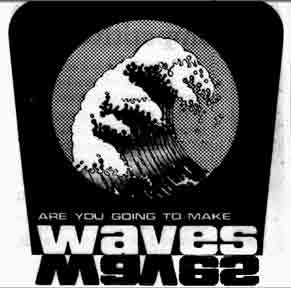
Waves advert 1975.
The decor in Waves was ultra-modern, with a sea theme vert much to the fore. Mirrors were designed by Ranald McCall, and he had used blues, greens, and whites to great effect.
As you enter you immediately notice the large square shaped bar. The seating areas had been divided into sea areas and waves areas. The waves areas had lots of mirrors on the walls showing sparsely clad young ladies coming out of the sea. The sea areas in the main part had red, white, and blue mirrors on the walls.
Near the back, an area had been set aside for eating meals prepared by chef Tony Matteo. The decor here was even more outrageous. Again blue, white and red was the main colours but there was also two large zips on the walls which when opened gave the impression of waves flowing out.
Behind the bar there was a large mirror designed in the shape of an air mail letter. “Like the other mirrors, this one had been specially designed for Brian and Robert.

Interior of Waves 1975.
Chef Tony had thought up some extra special menus. They included “Skinny ribs,” ham ribs with an apple and plum sauce, Mermaid Crisp, marinated scampi and a Waves Cruncher, grilled steak in French toast. They were also a selection of spaghettis, curries, and for starters, home made soup.
Tony also plans to have hot toasted sandwiches available for those looking for a snack. Meals were available from 11.30-2.15 p.m. and from 5 until 7.30 p.m. Sandwiches were available after that.
One part of the decor that Brian and Robert were particularly keen on was a section of mirrors behind the bar. If you look at it one way, it just looks like some vertical strip mirrors. But if you look at it from another angle you will see a red sunburst and it really was effective.

Waves advert 1979.
Brian and Robert hoped to attract the over 21’s to Waves and also hope that businessmen would drop in at lunchtimes. Music was from a jukebox, but the partners were also thinking about bringing in live music later.
Brian and Robert were looking forward to next summer for one main reason. They will be able to put tables and continental style umbrellas out on the walkway so that customers can have drinks and meals and enjoy the good weather. This was a first for Glasgow.
Custom House Quay was a new development with a ladies fashion shop the discotheque and Waves, partners were hoping that this popular area would have it’s own shopping area.
—————————————————————–
MANHATTAN.
IN THE NEWS 1978…
They’ve made a Spanking Job of the Manhattan.
Spankies Discotheque down at Custom House Quay has been a favourite nightspot for would-be John Travoltas for four years.
However recently dancers have had to do without the delights of the Clydeside disco, for the best of reasons.
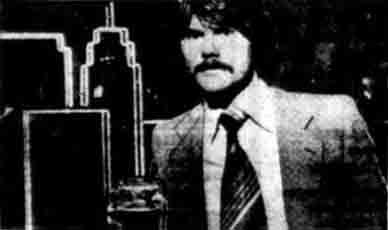
FEVER
For this Friday a new discotheque opens on the site and it will give Saturday night fever a whole new meaning. It’s the Manhattan and its for the over 21s. It could also prove to be one of the best disco places in Scotland.
I’ve been in quite a few discos but the Manhattan beats them all.
The interior design of the disco is all-important and directors of the company behind the Manhattan have chosen the famous New York skyline to model there’s on.
CIRCLE
They have used 3360 ft. of neon lighting to portray the skyline and with the clever use of the 200 mirrors they are able to project it again and again. No matter where you are, you will see the skyline flashing in bright green and red.
“It’s like looking into infinity,” said one of the directors. The directors had a lot to do with the choice of decor in the Manhattan. “We were over in the USA and picked up a few ideas from discotheques over there,” I was told. The seating is in black and silver and the wall coverings are in black hessian. The dance floor itself is glass.

Above the dance floor are more mirrors with a large neon circle, which again seems to stretch into infinity. “We have special lights round the dance floor which when lit up will give the impression of the dancers being in a lighted cage,” one director told me.
Two disc jockeys will play music which will be relayed through 36 speakers. The Manhattan is licensed till 2 a.m. and is open until 2.30 a.m. on Tuesday, Thursday, Friday, Saturday and Sunday nights. On Mondays and Wednesday the discotheque is available for private functions.
The directors of the Manhattan are justifiably proud. They feel that it adds a degree of sophistication to the dancing scene for the over 21s. And they think that the plush surroundings coupled with good discotheque music should prove a winner. After taking just one look at the Manhattan, I’m inclined to agree.
—————————————————————————————–
In the NEWS 1978…
McArthur’s, Custom House Quay…
City Pubs bid to go Continental…
Glasgow’s nightlife could take on a Continental look if applications are granted at the next sitting of the district Licensing Board.
One licensed restaurant, McArthur’s at Custom House Quay will open until 4a.m. if the application to be heard on March 10 is approved.
And late-night gamblers could find the days of cabaret and casino returning. Three city clubs, the Chevalier, the Regency, and the Princes, have applied for entertainment licences for 11 p.m. – 2 a.m. daily. The “Chev” when it first opened had dine, wine and dance facilities apart from the gaming tables.
SIMILAR
The owners of the Plaza Ballroom, in Victoria Road, have applied for a similar licence.
Rail travellers could be in line for a drink while waiting their trains at times out with the present licensing hours.
British Rail hope to have drinking hours extended from 2.30 p.m. 5 p.m. Monday – Saturday at their Queen Street and Central Stations’ refreshment rooms.
EXTENSION
Fruit market workers at Blochairn have to wait to find out it they will be able to down a pint between 8 a.m. 11 p.m. and 2.30 p.m. 5 p.m., the application was thrown out last time.
This time publican William Smith, of Stepps, hopes to be more successful, another licensee, Colin Brown, of Pollokshields, hopes to get an extension for his pub, afternoon drinking Monday to Saturday and 11 p.m. – 2 a.m. on Thursday, Friday, and Saturday.
The success of ex-boxer turned publican, Peter Keenan in winning an afternoon permit at the board’s first sitting may open the floodgates for other city hopefuls.
Forty pubs and clubs have applied for afternoon extensions, from 2.30 – p.m. of some type and one South Side publican seeks permission to serve alcohol between 11 p.m. and 12.30 a.m. on Mondays and Wednesdays.
Hasties Farm.
IN THE NEWS 1983…
Happy Days for the Nightclub.
Scotland’s top showbiz performers can again look forward to appearing at the Blantyre nightspot Hasties Farm, thanks to Glasgow entrepreneur Robert McFarlane. Mr McFarlane, who owns Panama Jax at Custom House Quay and another in Florida, re-opens the Lanarkshire venue on Friday. But he plans to close it again in January for a “thorough face lift,” according to my disco contacts.
Plans are already well advanced to restore the nightclub, where big names like Allan Stewart and singer Christian regularly topped the cabaret bill, to its former glory.
——————————————————————
PANAMA JAX.
Glasgow’s newest Restaurant and Discotheque was opened in 1983. In the same year The Devil’s Advocate was opened next door.

Panama Jax was my favourite disco which I frequented 7 days a week as a photographer. I remember the staff Roger Ferdinand, Benny and all the staff and doormen. The V.I.P. suite was very popular with the posers at the time or if there was a superstar in that night. The suite had cream or white leather chesterfield type seating with turtle tables with glass on top. I used this suite on a number of occasions when I was going out with my girlfriend (now wife).
At night Panama Jax had a massive queue to get in, it was one of the busiest night clubs in Glasgow. The music was always good as was the lighting displays. Panama Jax had two dance floors, during the week one of the dance floors was often hired out to private functions, on a Monday and Wednesday was used as a nightclub for the gay scene.

Panama Jax advert 1984.
IN THE NEWS 1989…
Scots who may sell the Wild West in Manhattan.
Scotland’s most unlikely export is about to launch itself on the world marketplace. The brainchild of a Glasgow builder turned publican, it has been test marketed with remarkable success in Scotland, and “refined” before it goes forth to multiply abroad.
The entrepreneur behind it is Robert McFarlane, the 42 year old head of the group whose base of a dozen pubs in some of the city’s less salubrious areas has been bolstered over the years with his building business.
It was a mixture of the two areas of operation that led to the development in 1986 of a “new concept” in eating out. Mr McFarlane had travelled in various parts of America with wife from South Carolina. He knew the British scene, particularly in London and Glasgow, and he saw a tiredness throughout, a dearth of new ideas.
He had already ventured, with some success, into the nightlife field in Glasgow, where his waterfront discos and diners had helped change the 10 pint of lager followed by a curry and four chapattis which characterised the post-fish and chip era.
COCONUT GROVE.
McFarlane was far ahead of his time in 1975 when he developed a waterfront site in the city centre, opening a pub called Waves near the Suspension Bridge. Waves was the first Glasgow pub to be granted a licence to allow drinking at tables outside. A year earlier he had opened the city’s first purpose-built discotheque, Spankies. Since then both places have changed with the developing taste of Glasgow’s younger citizens, Spankies became the Manhattan Night Club, and Waves metamorphosing into the Coconut Grove bar and diner.

Six years ago following a consolidation of the waterfront with the opening of Panama Jax disco and nightclub, still a popular venture with its two dance floors. At the same time an adjoining site was acquired for a more traditional style of pub, The Advocate, anticipating cleverly the resiting of the busiest court in Europe a few hundred yards away on the south bank of the Clyde.
Until 1986, all of the projects followed, or led, changes which were happening in the leisure field throughout Britain, which was hirpling along five years behind the U.S. A small but significant section of the leisure market was being consolidated in a city which was waking up after 30 years in the doldrums. A move pioneered towards river sites proved masterly as others large and small have followed with the crown point coming with the successful garden festival last year.
Plans are now released for a coordination of existing and future developments on the river from Cambuslang to Greenock. In 1986 Robert McFarlane went out on a limb, or perhaps it would be more appropriate to say, went up the creek. All sorts of cliches could be misused, playing with the theme “Go West, young man.”
That is exactly what he did. McFarlane set up a Wild West Restaurant in the basement of premises he had acquired in Carlton Place, the dilapicated remains of a terrace on the southern waterfront that had been one of the most prestigious residential stretches in Glasgow.
“I had this idea that was totally different from anything that had been established before. I wanted people to be able to eat good wholesome food in surroundings that would be both memorable and exciting, and I felt that the American idea of the barbecue could be translated to Britain, but only if it could be done indoors,” said Mr McFarlane.
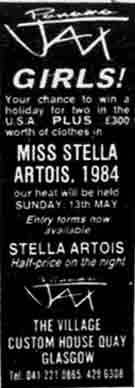
Special barbecue grills were designed for each table indoors. In consultation with the fire brigade and Glasgow District Council’;s health and hygiene department he evolved a gas-fired barbecue set into each table, with specially designed ducting to take away the fumes and the smells.
He engaged leading Glasgow designer Rony Bridges to create a frontier bar and surroundings which would be “different from anything else that has ever been done in Britain.” That objective was achieved with a bar that could have come out of an early Western, a talking horse, a street with gunsmiths, livery stables, and even the hint of the pleasures of a house of ill repute.
TRADING POST. opened in 1988.
Coffins and cobwebs and gunslingers mementoes and moose heads, and ammunition cases form the background. In keeping with the theme is the name “The Trading Post”.
“Our first Trading Post allowed us to experiment. Our second opened three months ago in Leith, again in a waterfront location, when the Wild West idea continued and expanded, and Western films projected on a huge screen as background both visible and audible and the ubiquitous talking horse with its changing zany (and sometimes controversial) script.

Mr Robert McFarlane in the Trading Post. 1989.
The McFarlane Group has now acquired its third Trading Post site at the top of Hope Street where Guy’s Restaurant operated for many years and which until recently was a Berni Inn. An expenditure of nearly £1.5m is planned to transform the stereotyped surroundings into “authentic” Wild West, with the detail and overall picture coming from Bridges, differing from the two existing Trading Posts, but conforming to what has become an established pattern.

Throughout the three years of experiment and plan, of trial and occasional error, all designs have been carefully protected by copyright. All the specially constructed barbecues and their accoutrements have been patented, using leading patent agents and under the supervision of franchise legal expert Mr Mike Bell. Mr Bell is also, by happy coincidence, one of the Law Society of Scotland’s whizz kids in setting up the machinery for Scots lawyers to provide first-class financial services.
“We now have our product right, and we plan to franchise the idea,” said Mr McFarlane, whose group HQ is above the first Trading Post in Carlton Place. “there have been many inquiries from people in the Midlands, and a tentative approach from someone in New York.”
At Carlton Place the backbone of the group can be observed. Franco Fraioli is managing director, under Mr McFarlane. He comes from an old Lanarkshire Italian family with a wealth of experience in hotels, restaurants, pubs and catering.
A sophisticated accounts system controls supplies and ordering and ensures that all of the company’s hostelries provide a nightly report of every transaction, which appears on computer printout each morning at head-quarters. “This allows central buying and complete control of stock, and analyses to the last detail what profit or loss has been made each day. In this way if something is slipping, it cannot slip to any significant degree before it is stopped.” said Mr Fraioli.
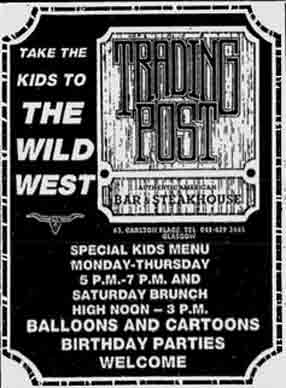
Trading Post advert 1988.
Perhaps the last word is best left to Mr Bell, the company’s solicitor. !I have observed many ideas in the world of franchising, but I must say that this is one of the most exciting I have have ever come across. For a Glasgow man to propose to sell a Wild West eating place to the Yanks must be the most gross of effronteries, but it is so outrageous that I’m sure it will work.”
However as time went buy, I can tell you that this idea never took off.
—————————————————————————————————-
DEVILS ADVOCATE.

Charlie is the toast of the girls.
Champagne Charlie Nicholas was living up to his name again this week, as he helped open the newest city nightspot. The Celtic hotshot was at the opening of the Devil’s Advocate at Custom House Quay Gardens, Clyde Street, Glasgow.
Joining him were lovely Joan Thomson (24) and Linda Bissett (22) who work in the new pub. The Celtic hero joined colleague Danny McGrain and other football stars at the opening of the new pub at Custom House Quay. 1983.
In the News 1983…
NEW CITY PUB COURTS OLDE WORLDE IMAGE.
A pub with great flair and style has just opened on the Clyde Walkway a few yards from the Suspension Bridge in the heart of Glasgow.
The Devils Advocate is more of an English-style tavern than a Glasgow pub. They have got right away from the flashing lights and plastic with richly polished wood and plush red carpeting which gives warmth and a slightly old fashioned charm. The theme of the Devil’s Advocate is, as the name implies, a courtroom and there are some super drawings on the walls of the Advocates addressing juries. They are prints which were bought from the Mitchell Library in Glasgow.

The rick wood is also reminiscent of courtrooms and is interesting in itself because it was salvaged from a church in Whiteinch in Glasgow. And what a joy it is to warm yourself at the big fire. The fireplace itself was bought from London, as was an elegant brass wall clock.
The furnishings are in keeping with the old tavern aspect with solid wooden tables and chairs. There are also elegant lounge chairs and Chesterfields for those who like their comfort.
There are two bars in The Devil’s Advocate, the main bar and a small, but elegant bar. Both bars are well stocked and there is draught wine or you can buy it by the bottle. They have a pretty reasonable selection of wines, including the popular ones, or, if you are celebrating, they have excellent champagne.
They have a big range of whisky and a selection of popular German beers. They also do a selection of cocktails and all the usual beers and lagers, naturally. The Devil’s Advocate also offers a good selection of food, from a cold meat salad to sardines on toast.

MENU
At this stage customers personal preferences are unknown, so if there is something you particular want don’t be afraid to ask for it. At the moment it might not be available, but if you and others ask it will be included on the menu.
But the one thing that is absolutely certain is that the food on offer is very reasonably priced. I must say I would have been quite happy with the meats and pies and chutneys and sauces that are on offer at the moment.

The tavern isn’t aiming at any particular clientel, just people who like to come out and enjoy themselves in a civilised fashion in delightful surroundings. There are nice touches in The Devil’s Advocate. For instance, all the day’s papers are laid out for you to read, free of charge, naturally.
And for the businessman who wants to keep in constant touch with what is happening in that rarefied stratosphere of high finance, there is a teletext television set with all the latest news from the Stock Exchange.
And how about this for a nice tailpiece? In the loos a series of cartoons have been painted which are on a courtroom theme and are really very funny.

Hats off to pub customers.
The Evening Times Lifeline Fund has been boosted by more than £300, raised by a Glasgow pub through a bonanza prize raffle.
The cash came from patrons of Panama Jax latest addition to the city’s night spots, on Clydeside. And before the money, £313, was handed over to our fund aimed at helping the very young and the old, barmaids Mary Adams and Morag Cameron took their hats off to their customers.
And Panama Jax boss Jim Mortimer said: “The prizes were wonderful, but so is the Lifeline charity. “If they’re are thanks to be given, It’s too the people who donated the prizes and the people who bought the tickets.”
Top of the lucky winners list was a one week holiday for two in Spain. There were also champagne dinners for two and free tickets to a top rock concert.

Devils Advocate advert 1983.
———————————————————————————–
PIER 39.
IN THE NEWS 1989…

New Pier Show
Hot times lie ahead down by riverside.
Pier 39 could with justification be called the hottest spot in town.
It is Glasgow’s latest, and possibly most elegant, place in which to wine and dine and it reeks of class and style. The proper name is Pier 39 Bar, Deli Restaurant and Ice Cream Parlour, an all-glass construction on the burgeoning waterfront at Custom House Quay.
It has taken around £2m to put together and gives the whole area a real Parisienne feel. It is an eye-catching building overlooking the Clyde. There are superb views of the river and the Suspension Bridge, one of the city’s best known landmarks and featured as a location for many films and TV programmes.

Mr Robert McFarlane 1998.
When the bridge is lit up in the evenings it provides a stunning backdrop to the equally stunning Pier 39. Once inside Pier 39, which has a nautical flavour, you get the impression of actually being afloat on the river without normal hazards, and there is no danger of suffering from mal-de-mer!
The use of wood floors, bars and panelling highlighted by brass rails and fittings enhances the nautical theme. The staff, dressed in their 1930s style deck gear, add the finishing touch. The interior design of Pier 39 gives a great sense of space, and the clever use of sails as a design feature adds to the seafaring ambience.

The building is on two levels. The upper deck, Pier 39, is 4500 sq.. ft and a brass spiral staircase connects it to the lower quarters, known as Morgan’s Landing. In contrast to the upper deck, Morgan’s Landing has an older and more piratical theme and customers can enjoy splendid views of the river and Carlton Place on the opposite bank while having a drink or a meal in the bar.
Currently the premises are licensed from 11 am until 2.30 pm and from 5 pm till 11 pm, Monday to Saturday. But they will open in the afternoons to serve coffee, croissants, sandwiches, and delicious American style ice creams. Food is available at both Pier 39 and Morgan’s Landing.
In the upper deck there will be a hot soup of the day, a range of hot specials, open sandwiches, and from the deli their own pate, pastrami, hot salt beef, roast beef, Virginia Ham, tuna and seafood cocktail.
There is a selection from the Salad Bar, and for an afternoon break why not indulge in croissant with preserves, Danish pastry, gateaux, or one of those marvelous ice creams.
In Morgan’s Landing you can choose from a mouth-watering selection of starters. For a main course there is a range of seafood platers, steaks, chops or the Chef’s Specials, which are fish of the day and a vegetarian dish. Sweets include Apple Annie, Pecan Pie.
IN THE NEWS 1989…
Pier 39 is all set to become one of the most swinging places in town for live music. Andy Boyle, top keyboard player, will introduce a host of guests on Mondays and Thursdays.
There will be a blend of music, ranging from the golden oldies to up-tempo disco music for young swingers. And on Wednesdays, Bobby Wishart takes the stage with his own brand of music which really gets the crowd going.

Franco Fraioli. 1989.
Maurey Richards, who blew into Glasgow from the Windy City, and who is one of the best singers around, will be making guests appearances with Bobby. At the weekends, Pier 39 will feature some of the more talented young bands. First will be Love Decree, who are responsible for the Chinheads song to promote a well-known lager. The date for this has yet to be announced.
The manageress of the new complex is Sharon Galbraith, a talented lady who, when the wine is cool and the music hot, can get up and sing along with the best of them. Group marketing director Roger Ferdinand says: “Good music and good food is what Pier 39 is all about.”
Pier 39 is the brain-child of Robert McFarlane, who has already brought the Clyde walkway to life. Fourteen years ago he opened the city’s first purpose built disco, Spankies, and has been involved in the forefront of the leisure industry in Glasgow ever since.
The McFarlane Group opened the city’s first waterfront pub, Waves, a year later, and it proved to be one of the busiest spots in town. Further development of the waterfront site was carried out 10 years ago when Spankies was doubled in size and reopened as Manhattan Night Club. Three years later Waves was converted into the Coconut Grove bar and diner.
The group consolidated these waterfront sites by opening Panama Jax nightclub, one of the busiest discos in the town over the past five years. The Advocate, adjacent to Panama Jax, was opened that same years, and has been converted to Morgan’s Landing.
On the southside of the river Robert McFarlane opened The Trading Post, where customers have the option of cooking their own meals at the table in a relaxed but sophisticated environment. This unique concept, combined with fascinating wild west decor, has really caught the imagination.
The company further developed the south bank with the opening of Hanrahans at Nicholson Street, which is designed on the concept of a Victorian gentlemen’s club, and later Knightsbridge SW1, an upmarket nightclub which is open seven days a week until 2 am.
It represents an investment of around £4m. The group has extended its interests with the successful building and operation of the Bennigans group of public houses.
IN THE NEWS 1978…
Brian Farquhar.

Mr Brian Farquhar 1978.
New York bound for a super stag party.
It’s bad enough that entertainments entrepreneur Brian Farquhar is planning a five-day stag party, but to have it in New York? The incredible binge begins on October 27 1978.
On that day a party of 20 publicans, bookmakers, and other businessmen fly out from Glasgow Airport to New York. Among the happy revellers will be Brian’s partner Robert McFarlane; Maryhill carper-cash and carry man Peter Ferguson; and James Mortimer, who owns the city’s Ballochmyle Pub Duke Street.
The groom-to-be runs Waves and Spankie’s discos, as well as the Iron Maiden pub in Bellshill. Brian told me: “It’s a wee bit different, and I think we will not forget it in a while.
“My partner doesn’t know it yet, but he’s buying me champagne over the five days.” The wedding, to Linda Ferguson, takes place in Circles Restaurant in Hamilton on November 9 1978.
Will there be anything unusual about the wedding? “Not really, there will be 200 guests, including comedian Andy Cameron and singer Allan Stewart. Perhaps they will do s wee turn for me at the reception.”
Meanwhile the stag party are getting decked out in Kilts before hitting the sidewalks of New York.
—————————————————-
IN THE NEWS 2 November 1978…
A 6000-mile round trip for the stag party to end all stag parties has turned a little sour for prospective bridegroom Brian Farquhar.
Disco boss Brian and 19 friends flew out from Glasgow on Friday to hold the stag party in glamorous New York. But after a riotous week-end disaster struck.
Brian missed the flight back and is now stranded in New York. Brian is to wed pretty Lynda Ferguson next Thursday. The popular boss of Waves and Spankies disco in Glasgow and the Iron Maiden pub in Bellshill missed the plane after leaving the airport to do a bit of last-minute gift buying.
When he returned the plane was on the runway taxi-ing for take-off. Brian is staying with friends in New York until he can confirm his flight back. After the wedding the couple will move into a luxury ranch-style house in Uddingston.
————————————————————–
The WEDDING…
Princess.
Lynda, Caroline, Look-a-like brides.
Every bride would like to be a princess on her wedding day, but 25 year old Lynda Ferguson had a better chance than most.
At her wedding in Hamilton today Lynda wore a dress copied from the outfit worn by Princes Caroline of Monaco at her wedding earlier this year.
Lynda from Cambuslang was marrying Glasgow pub owner Brian Farquhar in the unusual setting of a Lanarkshire disco. And the venue for the wedding was one of the reasons behind Lynda’s decision to copy Princess Caroline.

Lynda displays her bridal gown copied from Princess Caroline’s wedding dress in the classic setting of Pollok House, Glasgow. 1978.
She said, “I wanted to be married in white, but I didn’t want anything too formal since we weren’t being married in church. “I was looking for something slightly different, and not too starchy looking. I’ve always admired Princess Caroline’s style and when I saw her wedding outfit, I knew that was what I wanted.”
Lynda enlisted the help of Glasgow dress shop owner Jean Graham, who arranged for the dress to be made in London. Lynda said, “The dressmaker had to do a lot of work to achieve what I wanted, and although the materials used couldn’t compete with the expensive tastes of Princess Caroline, I think the end product is as near as possible to the original.”
Asked what the final cost was for her day as a princess, Lynda replied innocently, “I’m afraid I don’t know, Brian’s taking care of that.” But she’s satisfied the bill won’t turn her prince into a pauper.
——————————————————————————–
MacArthurs’…
IN the NEWS 1977…
A tasteful touch to the Walkway.
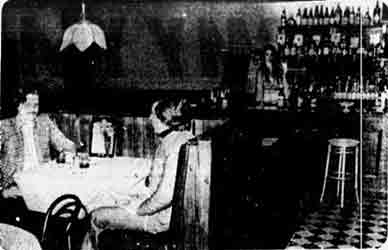
Interior view of MacArthurs 1977.
When I was a kid eating-out revolved around my ability to catch a piece thrown from a four-storey tenement window.
Fortunately, times change. We now live in a suburban bungalow, and my mother just hands me out a piece, sorry, sandwich.
However, it is a food fact that Glasgow’s attitude to eating out has matured in the last 10 years. You might say our heads are no longer full of mince.
The influx to take-a ways and curry-oouts has broadened thinking and waist-bands alternately. The Continentals take much credit, and plenty of cash, for that.
More recently the American-style hamburger-joints has bustled on to the restaurant scene.
PROMPTED
Appropriate then that Stateside should make way for Clydeside in Glasgow, and a new two tier seven days a week restaurant called MACARTHURS.
Situated in Custom House Quay Gardens, MACARTHURS is in the shadow of the Suspension bridge, formerly a prime site for the National Heider-intae-the-watter Championships.
The emergence of a walkway down there has prompted business interests such as a pub, a disco, and now a licensed restaurant. Who could ask for anything more?
MACARTHURS opened officially today, (20th January 1977), but has tested the market over the past few days with very encouraging results.
It provides a two-tier menu. You can have the burger-bit (plus relish, of course) or a more extensive choice of main course.
There are nine hamburger choices, six different steaks, beef stroganoff, chilli-con-carne, veal, chicken and salads.
Four starters and more finishers complete the menu. Prices are very reasonable. The one o’clock licence won’t go unnoticed either. I’ll drink to that.
Choice decor, controlled lighting, good music, and sensible table-planning give MacArthurs an intimate atmosphere although it can seat 120 people.
Dress is optional. You’ll feel equally at home in collar-and-tie or casual clothes. Personally, I felt at home at the bar at the door. Good thinking that. I’m told the owners intend doing a 99p business lunch, which by the very nature of the price should attract city-centre custom.
MacArthurs impressed me very much. So much so that I’m going along tonight. You’ll recognise me, I’ll have have a bar under my elbow.
One last point. MacArthurs advertise the fact that the chef, one of the 15 staff, will prepare any dish which does not appear on the menu, given 24 hours notice. I’ve ordered mince, with two eggs dropped in it. Lovely.
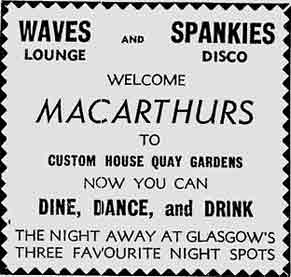
MacArthurs advert 1977.
————————————————————–
In 1977 Brian and Robert opened up a brand new establishment in Main Street Bellshill, named “THE IRON MAIDEN”.
Facts…
Managing director 1982 of Coconut Grove and Manhattan disco was Mr James Morton.

My friend Veronica and I were on holidays from Australia when we met Phil Drysdale in Glasgow. After a few months of travel around Europe we decided to go back to Glasgow and live their for a while. We lived at Phil’s place and got a job at Waves. We were quite well known there being Aussies. The bar was very popular and busy and I remember Brian Farquhar and Robert McFarlane well. Kathy Lagan and Morag Cameron were the chief barmaids and Alistair was the manager. Fantastic memories.
Dougie George….I was a bouncer there for a couple of years….miss those times